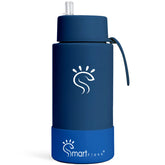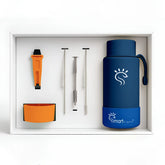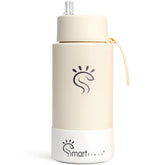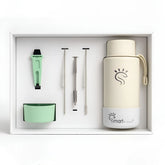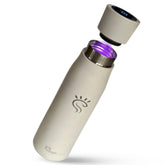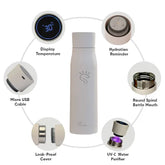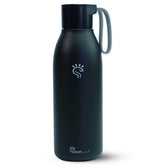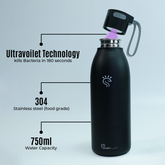How to Choose the Perfect Water Bottle for Kids?
Finding the perfect water bottle for your child may seem like a simple task, but it can actually be more challenging than expected. With numerous styles, sizes, and materials available, it's essential to choose one that meets your child's needs while encouraging hydration throughout the day. This guide will help you navigate the essential factors to consider when selecting a kid's water bottle to ensure your little one stays hydrated and happy.

1. Consider the Material
The material of the water bottle plays a crucial role in both its durability and how safe it is for your child. Let's take a closer look at the most common materials used for kids water bottles:
· Plastic Bottles
Plastic bottles are lightweight, affordable, and widely available. However, not all plastic bottles are created equal. It's essential to select a BPA-free plastic water bottle for kids to avoid exposure to harmful chemicals. Smart Flask's stainless steel smart purifier flask is one such good option, as it has a premium quality water filter to purify water before your child drinks it. While plastic bottles may be cost-effective, they can wear out over time and are less durable than other options. Therefore, it is better to either replace the bottle every few months or opt for a safer option.
· Stainless Steel Bottles
kids stainless steel water bottles are an excellent choice for parents looking for a durable, eco-friendly, and chemical-free option. Stainless steel bottles, especially insulated ones such as the hydration flasks by SmartFlask, are great for keeping drinks cold or hot for extended periods. This material is also resistant to dents and scratches, making it a long-lasting choice for active children. Stainless steel material is also safe for kids and won't leach chemicals into their drinks like some plastics might.
· Glass BottlesGlass water bottles are another chemical-free option and are often praised for their pure taste. However, they are more fragile than other materials, making them less ideal for younger children or those who may drop their bottles frequently. Some glass bottles come with silicone sleeves to minimize the risk of breaking, but stainless steel or plastic may still be a better option for kids who are hard on their belongings.
2. Look for an Insulated Design
Choosing an insulated kids' water bottle can make all the difference, especially if your child enjoys cold beverages throughout the day. An insulated kids' water bottle is designed to maintain the temperature of liquids for extended periods. Whether your child prefers icy cold water or warm drinks, an insulated bottle will ensure they have access to their preferred drink temperature during school, sports activities, or family outings.
Benefits of Insulated Kids Water Bottles

-Temperature Control: Keeps drinks cold for up to 24 hours or hot for up to 12 hours, depending on the bottle design.
-Durability: Insulated bottles, especially those made from stainless steel, are built to withstand the wear and tear of daily use.
-Eco-Friendly: Since these bottles can be reused over and over, they help reduce plastic waste and keep our environment eco-friendly.
When considering a kid's insulated water bottle, check if it has a double-wall vacuum insulation feature. This is the most effective technology for keeping liquids at their desired temperature. For kids who have extended school days or engage in sports, an insulated smart bottle such as a UVC LED flask will ensure they stay hydrated with cold water or a warm drink throughout the day.
3. Prioritize Safety
Safety is a paramount concern for any product used by kids, and water bottles are no exception. When selecting a water bottle for kids, make sure it is:
- BPA-free: BPA (Bisphenol A) is a chemical found in certain plastics that can be harmful to health, especially for children. Always check that the bottle is BPA-free.
- Spill-proof: Kids can be clumsy, and a water bottle that leaks all over their backpack or spills during use can cause frustration. A spill-proof kids' water bottle with a secure lid or cap is essential. You can have a look at Smart Flask for better hydration and reusable water bottle options for your kid's school use.
- Non-toxic materials: Whether you choose plastic, stainless steel, or glass, ensure that the water bottle is free from any harmful chemicals that could affect your child's health.
4. Check the Size and Design
The size and design of a water bottle are vital factors to consider for comfort and ease of use. A water bottle that is too large might be cumbersome for a child to carry around, while one that is too small may not provide enough hydration for the day. Typically, a 12-16-ounce water bottle is suitable for younger kids, while older children may prefer a more significant 18-24-ounce bottle.
Size Considerations
- For younger kids: A smaller, lightweight bottle that can easily fit into their lunchbox bag or backpack is ideal. It should be easy for them to hold and drink without assistance.
- For older kids: A slightly larger bottle or a Jumbo water tumbler holding 1 liter of water is usually better, especially for those who are active and need more water throughout the day. You can have a look for bottles with handles or straps for easier portability.
Design Considerations
- Fun and Appealing: Children are more likely to use their water bottle if they find it appealing. Smartflask Water bottles for kids come in a wide range of colors, patterns, and themes to suit different tastes. Let your child choose a design they love to encourage consistent hydration.
- Easy-to-use caps and straws: Consider a water bottle with a flip-top lid, straw, or spout to make it easy for your child to drink without unscrewing a cap. These features also help prevent spills and make drinking water more accessible, especially for younger kids.
5. Durability and Easy Maintenance
Kids are active, and their water bottles need to withstand the daily wear and tear of school, sports, and playtime. A durable kids' water bottle, especially one made from stainless steel, is an excellent investment. Look for bottles that are resistant to dents, scratches, and breakage.
Ease of Cleaning
- Dishwasher-safe: Many parents prefer a water bottle that can easily be tossed into the dishwasher for cleaning. Check if the bottle is dishwasher-safe to make your life easier.
- Wide mouth for easy cleaning: A water bottle with a wide opening allows for easy hand cleaning. This feature also makes it simpler to add ice cubes or mix in flavored water options, which kids might enjoy.
6. Environmentally Friendly Options
Choosing a reusable water bottle for kids is not only good for their health but also for the environment. By opting for a durable and long-lasting water bottle, you reduce the need for single-use plastic bottles that contribute to pollution. Stainless steel bottles, in particular, are a fantastic eco-friendly choice as they are fully recyclable and highly durable.
Conclusion
Choosing the perfect kids' water bottle requires careful consideration of various factors, including material, insulation, Safety, size, design, and durability. Whether you're opting for a kid's stainless steel water bottle or a lightweight plastic one, make sure it meets your child's hydration needs while being easy to use and maintain. Encouraging your child to stay hydrated throughout the day can be much easier when they have a water bottle that suits their lifestyle and preferences.
Investing in a high-quality, reusable water bottle for kids not only benefits their health but also contributes to a more sustainable environment. With the right water bottle, your child will stay hydrated and happy, no matter where their adventures take them.

